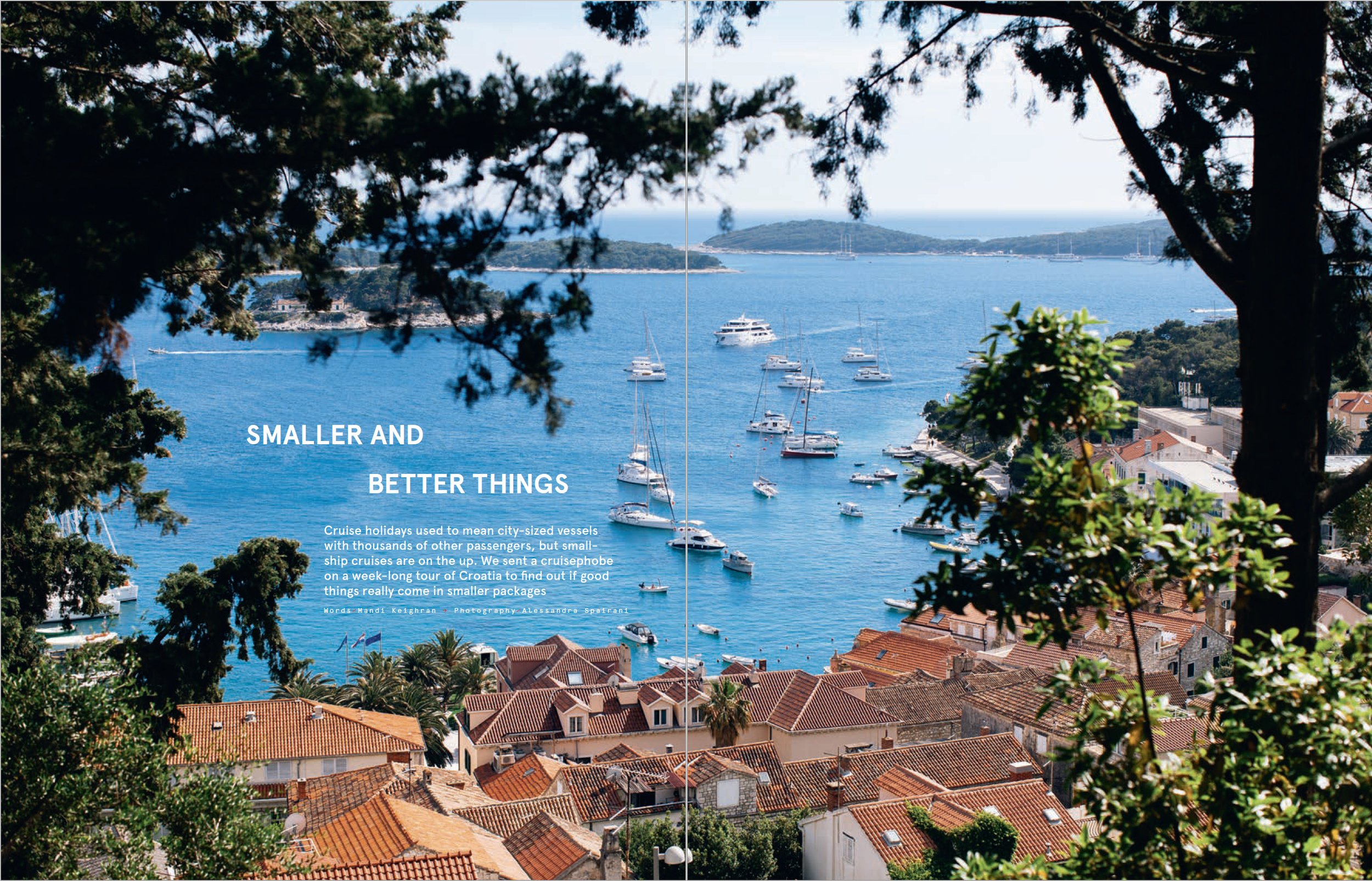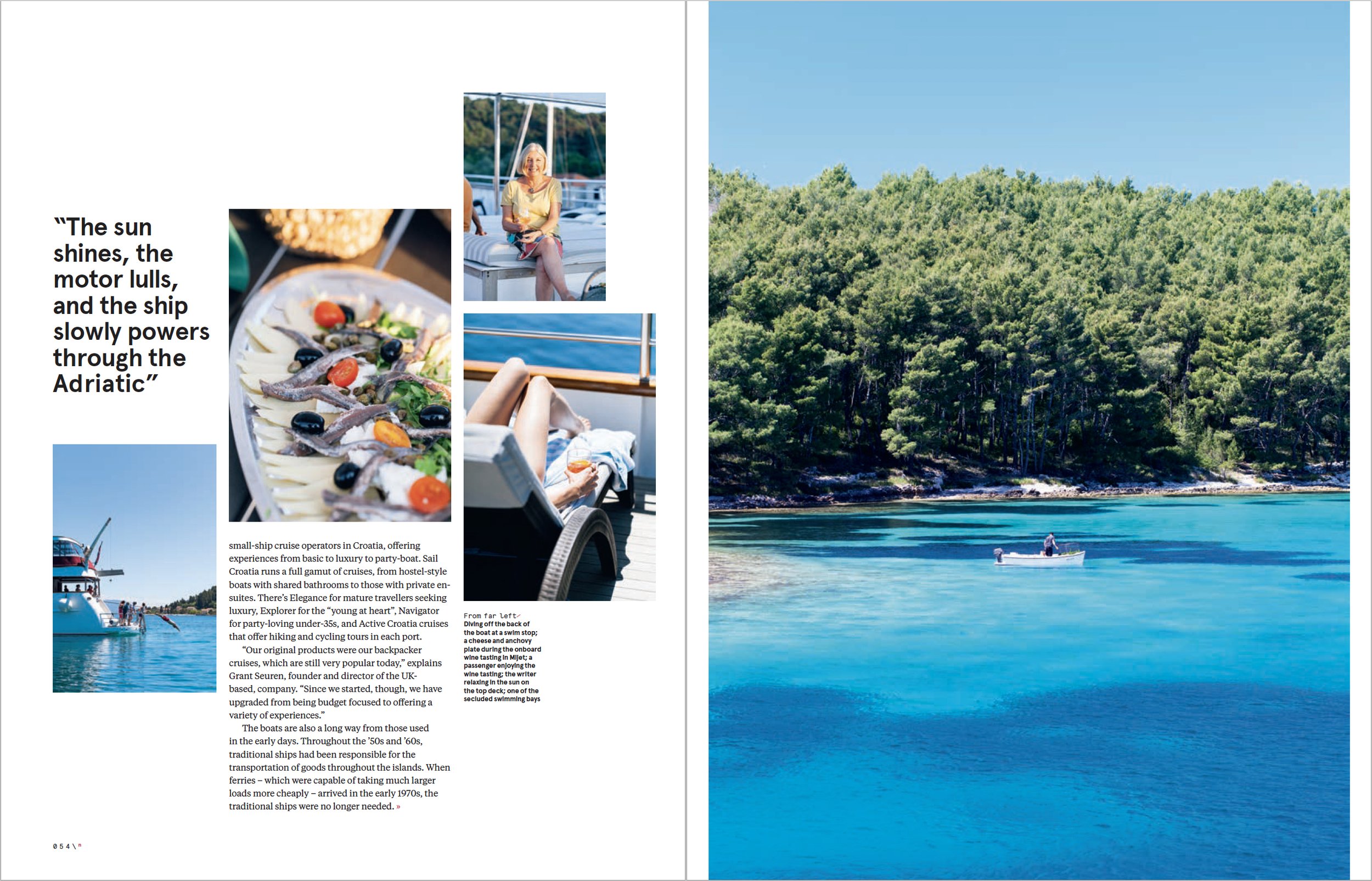N by Norwegian
Norwegian Air inflight magazine | August 2017
Smaller and Better Things
Cruise holidays used to mean city-sized vessels with thousands of other passengers, but small-ship cruises are on the up. We sent a cruisephobe on a week-long tour of Croatia to find out if good things really come in smaller packages.






I’d never been on a cruise before, but having read David Foster Wallace’s A Supposedly Fun Thing I’ll Never Do Again – a darkly humorous essay in which the American author recounts a seven-night Caribbean cruise he took in 1996 for Harper’s Magazine – I was certain that this kind of holiday wasn’t for me.
Take, for example, the following excerpt: “I have smelled suntan lotion spread over 2,100 pounds of hot flesh… I have seen 500 upscale Americans dance the Electric Slide… I have heard steel drums and eaten conch fritters and watched a woman in silver lamé projectile-vomit inside a glass elevator… I have seen nearly naked a lot of people I would prefer not to have seen nearly naked.”
Why then, given Wallace’s vitriol, and my certainty, would I agree to go on a week-long island-hopping cruise with Sail Croatia? Well, for one thing I was assured that small-ship cruising is an entirely different experience to the horror that Wallace endured. Billed as one of this summer’s big travel trends, small cruise ships take from just eight up to 250 passengers, promising a more intimate and eco-friendly experience.
For another, Croatia is the home of small-ship cruising; island-hopping trips on smaller vessels have been run here since the 1970s. The country is home to more than 604 islands, from tiny, uninhabited islets to famous ones such as archaeological wonderland Vis, party capital Hvar, and the white beach- circled Brac. Together, they cover a total area of around 3,300km2. Regular ships are too large to navigate many of the smaller islands and bays, giving passengers on these trips a distinct advantage.
My interest piqued, one sunny June morning I find myself in Split, boarding an elegantly appointed 49m-long boat with 38 other passengers. Our home for the week, the Diamond, is captained by the jovial Mario – who comes from a long line of Croatian sailors – and has just 20 cabins.
It doesn’t take long to fall into the rhythm of life aboard. Each day, the sun shines, the motor lulls, and the ship slowly powers through the Adriatic Sea. We wake early as we pull out of port, eat a buff et breakfast, then sunbathe and relax with a beer or aperitif until it’s time for a mid-morning swim break in small bays where the water is so gloriously blue that it renders filters redundant. The swim is followed by a three-course lunch and a destination talk from Ivo Reic – who works as a cruise manager in the summer season and a marine biologist during winter – as we make our way to the next port, where guests are free to explore as they wish.
Our Split-to-Dubrovnik route stops in at the tiny fishing town of Milna on Bra?, then Hvar, Mljet and Dubrovnik, before heading back to Split via Korcula and Makarska. Each port offers something new, and Reic is eager to ensure that everyone gets an experience suited to them. “This is more of a hobby than a job for me,” he says. “I like working with people and on a boat this size you can provide much more individual guidance based on people’s specific interests – some want history and culture, some want to do activities, and others just want to relax.”
His attitude comes as something of a relief, as I’d been worried about enforced group ‘fun’. In fact, there’s no hint of a casino or floor show at any point during the week, unless you count the traditional musicians who provide entertainment during the captain’s dinner and intersperse Croatian classics with the occasional golden oldie.
Of course, you can choose a cruise that does do gambling and jazz hands. There are now six major small-ship cruise operators in Croatia, offering experiences from basic to luxury to party-boat. Sail Croatia runs a full gamut of cruises, from hostel-style boats with shared bathrooms to those with private en-suites. There’s Elegance for mature travellers seeking luxury, Explorer for the “young at heart”, Navigator for party-loving under-35s, and Active Croatia cruises that offer hiking and cycling tours in each port.
“Our original products were our backpacker cruises, which are still very popular today,” explains Grant Seuren, founder and director of the UK-based, company. “Since we started, though, we have upgraded from being budget focused to offering a variety of experiences.”
The boats are also a long way from those used in the early days. Throughout the ’50s and ’60s, traditional ships had been responsible for the transportation of goods throughout the islands. When ferries – which were capable of taking much larger loads more cheaply – arrived in the early 1970s, the traditional ships were no longer needed.
“Suddenly, there was a fl eet of boats that wasn’t being used,” explains Reic. “Then, in the late ’70s, one ship owner had the idea to use his to take some German tourists island-hopping. He transformed it to have cabins on one deck, and it was a big success.” Soon, French tourists also began to travel Croatia’s islands by boat, and the rest of the world followed suit.
The success of the industry here has been a win-win for Croatia. “It brings income to ports and towns that don’t benefit from the large cruise ships. Plus, the ships themselves are built in Croatia and owned by the captains – a wonderful example of how sustainable tourism models can work,” says Seuren.
“It provides an experience of Croatia you can’t have any other way,” adds Reic. “Small ships can navigate between the islands and inlets with ease, and are able to drop anchor at those secluded bays bigger cruise ships can’t get to.”
We reap the rewards in Milna, where we eat smoky cooked octopus peka (a local dish of potatoes and meat cooked on a grill under a metal dish) at the charming family-run Restaurant Bago. In Hvar – which, this early in the season, doesn’t live up to its reputation as party central – where we hike up to the fortress for spectacular views. And in the national park on Mljet, where we go snorkelling in Malo Jezero (the “small lake”) to see the giant fan mussels that populate the lake bed, their shells – which can grow up to 1.2m long – protruding from the sand like tombstones in an underwater graveyard.
Following four days in tiny ports, Dubrovnik comes as something of a shock. The streets are heaving with tourists – many from the three large cruise ships that have pulled into port that day – but the view from the wall is spectacular. Perhaps more charming (and certainly less busy) is Korcula – often called “Little Dubrovnik” – a small island on which the old town can be circumnavigated in just 20-odd minutes. Here, we ascend a steep ladder to the top of the 15th-century Zakerjan Tower and drink cocktails – ferried up by a basket attached to a pulley system on the side of the turret – overlooking the harbour.
After a week onboard the Diamond, full of these kinds of experiences, I’m a cruise convert. Unlike Wallace, this is a supposedly fun thing that I will do again. Hopefully soon.